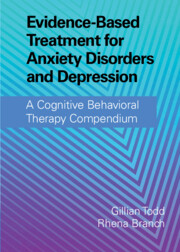 Evidence-Based Treatment for Anxiety Disorders and Depression
Evidence-Based Treatment for Anxiety Disorders and Depression Book contents
- Evidence-Based Treatment for Anxiety Disorders and Depression
- Evidence-Based Treatment for Anxiety Disorders and Depression
- Copyright page
- Contents
- Figures
- Tables
- Contributors
- 1 Introduction
- 2 The History and Philosophical Underpinnings of CBT:
- Part One Cognitive Behavioral Therapy for Anxiety Disorders
- Part Two Cognitive Behavioral Therapy for Posttraumatic Stress Disorder
- Part Three Cognitive Behavioral Therapy for Obsessive-Compulsive Disorder and Associated Disorders
- Part Four Cognitive Behavioral Therapy for Depression
- Part Five Complexity and Comorbidity in Anxiety Disorders and Depression:
- Part Six Specialist Applications of Cognitive Behavioral Therapy for Anxiety Disorders and Depression
- 24 The Application of CBT for Adults with Learning Disabilities
- 25 Cognitive Behavioral Therapy for Children and Adults with Autism
- 26 Adapting CBT for Treating Anxiety Disorders and Depression in Adults with ADHD
- 27 Adapting CBT for Children and Adolescents with Anxiety Disorders and Depression
- 28 Adapting Cognitive Behavioral Therapy for Older Adults with Anxiety Disorders and Depression
- 29 Cross-Cultural CBT
- Part Seven Future Developments
- Appendices
- Index
- References
29 - Cross-Cultural CBT
from Part Six - Specialist Applications of Cognitive Behavioral Therapy for Anxiety Disorders and Depression
Published online by Cambridge University Press: 06 January 2022
- Evidence-Based Treatment for Anxiety Disorders and Depression
- Evidence-Based Treatment for Anxiety Disorders and Depression
- Copyright page
- Contents
- Figures
- Tables
- Contributors
- 1 Introduction
- 2 The History and Philosophical Underpinnings of CBT:
- Part One Cognitive Behavioral Therapy for Anxiety Disorders
- Part Two Cognitive Behavioral Therapy for Posttraumatic Stress Disorder
- Part Three Cognitive Behavioral Therapy for Obsessive-Compulsive Disorder and Associated Disorders
- Part Four Cognitive Behavioral Therapy for Depression
- Part Five Complexity and Comorbidity in Anxiety Disorders and Depression:
- Part Six Specialist Applications of Cognitive Behavioral Therapy for Anxiety Disorders and Depression
- 24 The Application of CBT for Adults with Learning Disabilities
- 25 Cognitive Behavioral Therapy for Children and Adults with Autism
- 26 Adapting CBT for Treating Anxiety Disorders and Depression in Adults with ADHD
- 27 Adapting CBT for Children and Adolescents with Anxiety Disorders and Depression
- 28 Adapting Cognitive Behavioral Therapy for Older Adults with Anxiety Disorders and Depression
- 29 Cross-Cultural CBT
- Part Seven Future Developments
- Appendices
- Index
- References
Summary
Cognitive behavior therapy is the treatment of choice for a wide range of mental health difficulties in the United Kingdom, Europe, North America, Australia, and New Zealand, but research evidence suggests that access to this therapy and clinical outcomes for patients is worse for patients from Black and minority ethnic (BAME) backgrounds compared with patients from white majority communities in most of these countries. This chapter looks at the changes that services and therapists can make to adapt the way that they work to ensure that access and outcomes for minority communities improve. Some of these changes are modest, such as ensuring that therapists acknowledge ethnic and cultural differences; however, some might need more extensive adaptation such as developing family system maps that take into account the beliefs, practices, and migration histories of different family members or understanding how spiritual beliefs can be incorporated into treatment plans. This chapter provides a practical and accessible framework for adaptation and suggests further reading to support the development of therapist skills in trans-cultural assessment and treatment of mental health problems when working with patients from BAME communities.
- Type
- Chapter
- Information
- Evidence-Based Treatment for Anxiety Disorders and DepressionA Cognitive Behavioral Therapy Compendium, pp. 620 - 640Publisher: Cambridge University PressPrint publication year: 2022


